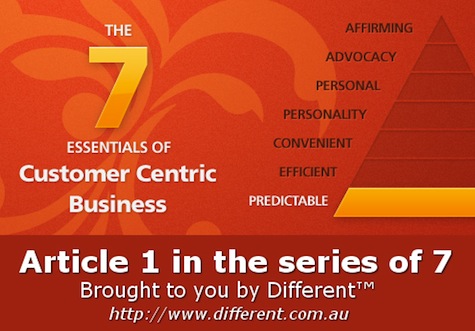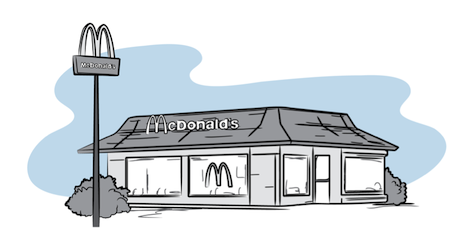This year marks our tenth anniversary here at Different. Over that time we’ve always tried to stay true to our philosophy that great UX is always grounded in solid research, designed to exceed expectations, and tested thoroughly. But when you use that process, what consistent criteria to you use to define experience?
That question led us to develop the Essentials of Customer Centric Business, and as part of our anniversary celebration we’ve decided to share it with the UX and business community. At first glance it can appear to be just another UX infographic or a version of Maslow’s hierarchy of needs. But, as we will demonstrate, it contains many layers and provides a great deal of practical information for UX practitioners and businesses alike.
This month we’ll start by discussing the first essential: being predictable. Over the next six months we’ll continue across all seven of them here on UX Magazine. It’s our hope that you will find this series as informative and valuable as the essentials have become for us.
Have you ever walked up to a door and grasped the doorknob expecting that familiar turn, click, and open, only to be startled when it did not operate as you expected? Recently a visitor to a hotel described how a closet in his room had a doorknob that looked like it should turn, but did not. Instead the knob was simply screwed in and the door held shut by a magnet. He described how that bothered him and that he never got used to it. Every time he went to use that door it bothered him. Its behavior was unpredictable, both in its lack of intuitiveness and its inconsistency with every other “door experience” he’d ever had.
Well, what is true for doors is also true for a lot of other things. Much of the research conducted by Different shows that many customers are not satisfied with their service providers or with the products that they use because of a lack of predictability.
You may think that predictability is a no-brainer, or even boring. But we think it’s underrated. Many organizations large and small lose business as they fail to deliver a predictable experience to their customers. Common examples include inconsistent levels of knowledge among staff, unintuitive products, and poor management of customer expectations.
What Is Predictability In UX?
The immediate temptation we all have is to define predictability in relationship to repetition or consistency, but this is just a part of its meaning. The root word it descends from is the Latin “praedictus,” which translates as “to foretell.” So we must always remember that predictability comes into play during completely new experiences as well as in comparison to previous ones. So in order to apply it correctly we must define it thusly:
“Predictability in UX can be defined as how much a user can successfully foresee the result of an interaction.”
This can involve the meeting or matching of their expectations, whether in an initial experience or a repeat one. Conversely, unpredictability occurs when customers do not know what to expect or they expect something different to what they experience. In the example above, the customer predicted that the door would work as he expected, and then it didn’t. Similarly, online shoppers expect their purchases to be shipped quickly and providers who don’t meet this expectation are unlikely to get repeat business.
However, predictability extends further than these examples. It’s also about successfully matching a customer’s mental model of what an experience should be. Mental models are internalized expectations of how the world works that customers use to predict outcomes.[1] Meeting and managing these predictions are critical to business success.
Why Is It Important?
Why is predictability such an essential component of an experience? The clear outcome of a positive, predictable experience is the effect it has on customer satisfaction. Generally, it enhances the perception customers have of the company, and affects sales growth positively. Take McDonalds, for example; when it came into the market it created a worldwide phenomenon. Customers were given the same predictable experience every time they bought—no-frills, fast and friendly service, with food that tasted exactly the same every time, no matter when or where. The concept worked so well that, at one point, McDonalds was opening one store a day.[2] It is easy to see how they have mastered a component of predictability through consistency.
Having predictability creates a positive psychological impact on customers. Customers given information about what to expect in an interaction feel confident and prepared, and are therefore more relaxed during the interaction. By the same token, a lack of predictability affects customers negatively. Unexpected events can capture their attention [4] and distract them from their goal or purpose as they seek to understand how their expectations were misaligned.
For customers, predictability provides three major benefits:
- A sense of control
- Trust and safety
- Reliability
Recall the last time you went grocery shopping; for items that you buy regularly, you know the exact location in which they can be found every time. This predictability gives customers a sense of control in an environment that can be otherwise stressful due to overstimulation and a division of attention between social awareness and the task of locating things. Woolworths in Australia is proud of the fact that the majority of their stores have the same layout. Any supermarket retailer will tell you, the one thing that causes more customer complaints and defections is moving a product from one shelf to another, so move the tomato sauce at your peril!
Unpredictability can create uncertainty and undue stress that erodes customers’ sense of safety, which in turn reduces trust in the provider. During the recent global financial crisis many financial markets became volatile and moved in ways that felt random. As a result, investors were filled with fear and decreased their activity, or withdrew from the market entirely. This had the effect of compounding the problem and deepening the crisis.
Feelings of trust and safety are most critical where serious matters such as money and life are involved. What if you could not rely on the predictability of your local ambulance or fire service? Predictable services or products in sectors such as government, financial, medical, aeronautical and emergency services are crucial in maintaining peace and stability in society, as well as preserving lives.
The success of companies such as Toyota is built on perceived reliability, which is another form of predictability. Its ability to maintain consistent build quality year on year, producing cars that rarely break down has earned Toyota its reputation of being reliable. Toyota was able to penetrate the saturated US car market on its reputation of being reliable and it now holds the enviable position of top-selling auto manufacturer globally.
How to Achieve Predictability
Incorporating and achieving predictability in your service, interaction, or product is an important undertaking and requires much consideration and planning. It is essential to understand and match customer expectations and provide service or product consistency to generate a positive user experience. Ultimately predictability will impact your overall customer satisfaction and sales.
Make it intuitive
Again, it is critical to remember that predictability is about the ability of customers to foresee the future course of events as they interact with a company. It’s more than merely being consistent. Some companies attempt to resolve this by educating customers about how their internal processes work. But this tactic is a poor fix because they’re just trying to get customers to think like them. The correct solution is to understand what customers expect and then align internal practices with that. When customers experience this, they often report that the experience felt “intuitive” and went exactly as they had hoped.
It is essential to begin with research to understand their mental models, and where your product or service disconnects from them. Companies looking to improve predictability need to understand why customers call customer service or go online for help, as these are instances where their mental models don’t match the product or service model—in other words, they can not predict how the thing works. Analyzing service calls or online forums and bringing the issues to the development team is one way to start putting predictability back into the user experience.
For example, telecommunication companies tend to focus on improving conversion rates through creating diverse product offers, but often pay less attention to the root causes of abandonment in their sales funnels. Many of their signup processes don’t align with customer expectations, causing errors. After futile attempts to recover, frustration with a lack of progress outweighs the customer’s desire to persist. When designing systems like these, it must be remembered that ease of use is a factor in whether the workings of the system can be predicted by users.
Implement standards & guidelines
Implementation of standards and/or guidelines in services or products will help ensure predictable customer experience as they limit the number of different ways an interaction can work. Therefore, there’s less for customers to learn and they can predict the interaction more readily. Apple products clearly demonstrate that standards and guidelines create predictable experiences. All iPhones, iPods and Apple computers have an almost identical look, feel, and interaction model, as do their stores. This predictable experience contributes to positive customer satisfaction and uptake of their various products.
Contrast this with the Android phone experience. Clearly, balancing consistency and customisation is a challenge for them, as the user experience from one Andriod phone to another can be quite different. Google allows hardware vendors to heavily brand the Android experience through look, feel, and function. As a result, some devices differ dramatically. This impedes customer satisfaction when switching to different models of Android phone and prevents customers predicting whether any given Android phone will be a good one. Overall, this unpredictability degrades the Android brand.
Mitigate unpredictability
What happens when customers encounter unpredictability? How do you rebuild trust and put predictability back into their experience? When a normally predictable product or service becomes unpredictable, customers become extra stressed because their trust is violated. In these situations, a proper response is critical to reestablish trust. During this kind of crisis, swift corrective measures and management of expectations can curtail lasting negative effects. Last year, Toyota’s crisis concerning brake failure struck the heart of their safe and reliable image. Only fast action on their part to recall vehicles and launch a thorough NASA-powered investigation avoided a publicity disaster [5]. A lesser response would have eroded customer’s perception that Toyotas were a predictably good car. It was the swift, decisive response and obvious dedication to putting the issue right that reestablished Toyota as a brand that could be trusted.
When a product or service is unpredictable, such as a financial instrument or medical diagnosis, the most constructive way to tackle the problem is to be transparent about the process with customers. Let them know how the product or service is governed. For instance, a doctor being transparent about the treatment plan for a patient about to undergo cancer treatment allows the patient to feel a sense of control in the face of a medical crisis. Such transparency empowers customers and reduces the element of fear around the unknown. It puts some predictability back into the experience.
Risk management (aka insurance) can also mitigate inherently unpredictable product or service elements, by providing comfort and security to customers to alleviate fear. This is why many financial institutions offer insurance on high-risk financial products. It neutralises the customer fears of unpredictable results.
For the UX Practitioner
Revealing the underlying causes of a failure in predictability.
The key to finding the causes of predictability failures lies in the contrast between how a product or service actually operates versus what customers expect. To define this contrast:
Start with the customer
- Submerge yourself in the customer’s experience through a series of thorough contextual inquiries. Nothing beats true in situ (observing customers doing things in the field) feedback from people who are living it.
- For longer processes, consider a diary study where real customers record their thoughts and feelings for you and report in regularly.
- Consider secret shopping the experience yourself and documenting it as you go.
- Map this data into an end-to-end journey and define the major phases with the smaller phases contained within them.
- Note break points where customers expected something different than what they got.
Rinse and repeat with the business
- Submerge yourself in the business process by following it from beginning to end.
- Interview the key stakeholders to understand how this process came to be, and the reasons behind it.
- Spend time with the employees who actually implement the process and document the ways that they enforce or deviate from it when necessary.
- Map this data into a complete journey and define major phases with the smaller phases and tasks contained within each.
Contrast the journeys
Starting at the beginning of the two journeys, contrast each step and document every possible problem this presents to the customer. Where was what they expected not matched by the business process? Focus on areas where customers express the greatest distress. Contrast the comments they make at these stages against the conflicts you see.
The Risks of Predictability
There is very little in the design world where a “one size fits all” approach is best. Predictability as the basic design element of customer experience is no exception. It comes with a price tag, since there can be downsides when predictability is at the core of an experience.
Stifling innovation
Predictability can stifle innovation when standards aren’t questioned and progressed. This introduces your first risk. Before Apple introduced the iPod click wheel and iTunes, every MP3 player had the same user experience dating back to the VHS era. Would Apple have taken a leading position if the standard had prevailed and they never pioneered their new intuitive interaction and enhanced service offer? Apple was able to be different without losing its competitiveness through introducing learnable interface and new service model that was significantly better than the standards at the time.
Raising expectations
The second risk in focusing on predictability is raising expectations. If you maintain a high degree of consistency, customers will experience breakdowns more acutely. A common example of this is timetables. If the timetable states the bus should be at your stop at 7:45am, even a 10-minute wait can feel excruciating. Yet, we all know that the bus timetable has factors beyond the control of the bus company. City Council in Queensland is moving away from timetables for high frequency buses to combat customers’ inevitable disappointment. Instead, these services are based on frequency and operating time, e.g., the service runs every five minutes between 7-9am and 4-6pm weekdays [6]. This focuses the customer’s attention on the likely wait time, rather than on an exact minute of arrival.
Reduced opportunity for delightful experiences
The final risk can be summed up in that old saying that “variety is the spice of life.” Can you imagine how boring the world would be if every experience was predictable? Some companies attempt to change their products with promotional offers during certain periods of the year to draw customers’ attention. In this way, Starbucks maintains regular offerings but features promotional products during special periods and seasons of the year. So, ironically, Starbucks is practicing predictability because its customers know that every autumn, pumpkin chai lattes will be offered, and at Christmastime peppermint tea will be on the menu.
In some cases, though, deliberately unpredictable promotions and sales can be a marketing tactic. They draw the attention of customers to a break in the normal offers by a company. This is commonly referred to as “surprise and delight” and runs counter to predictability. Concierge Traveller, a company that tailors travel experiences for their clients, has a policy of not telling their clients every detail of their itinerary. This way, when their clients arrive there is always a surprise, enabling delight. So when you make predictability a focus, don’t forget to spice it up a little.
For Businesses
How do you measure your level of predictability?
Are you worried you’re not predictable enough? The warning signs are actually easier to see than you might think. Take a few weeks and examine a single process in your business structure and predictability issues get easy to spot. Online, paper based, and service interactions can all be examined with this method.
Ask the right people
Start at your call center. When predictability breaks down your call center staff is the emergency crew that handles it.
- Have support staff track the number of calls for the process in question and the overall reason for the call:
- Customer didn’t understand the product functions or features.
- Customer didn’t understand the process.
- Customer had unrealistic expectations of time and number of steps.
- Customer was surprised by the bill, cost, or fees.
- If a large volume of support calls fit the above issues, then there is likely a predictability problem to be addressed.
Conclusion
Throughout this article, we have highlighted successful examples of predictability as a part of core customer experience. But a final question remains: how hard is it to achieve the right level of predictability in a customer centric business?
The key thing to remember is that the ability to provide a predictable positive experience has a direct correlation with your ability to successfully match the customer’s mental model of that experience.
You can achieve this best by uncovering that model and then designing to it. You must remember to maintain consistency in experience through implementation of standards and guidelines, which can create its own challenges. Set clear expectations around outcomes or processes, but have a risk management plan in place for unpredictable events. Lastly, remember that there are times to be unpredictable, but they need to be the exception, not the rule. In the end, building for predictability properly can positively impact your overall customer satisfaction and sales.
Mastering predictability is critically important, but it’s only the first step in building a truly customer centric business. Without predictability, other values of the pyramid such as efficiency, convenience, personality and advocacy, have less impact. In the next article in this series we’ll discuss the next level of user experience: efficiency.
References
- Craik, KJW 1943, The Nature of Explanation, Cambridge University Press, London. [back ^]
- McDonald’s History. A brief overview of the history of McDonald’s. McDonald’s Corporation. Viewed 16 April 2011. https://.mcdonalds.ca/pdfs/history_final.pdf. [back ^]
- Keane, AG 2011, Runaway Toyotas Cleared by U.S. of Electronic Flaws, News article, February 08, Businessweek, viewed 5 May 2011, https://.businessweek.com/news/2011-02-08/runaway-toyotas-cleared-by-u-s-of-electronic-flaws.html. [back ^]
- Yantis, S 1993, ‘Stimulus-Driven Attentional Capture and Attentional Control Settings’, Journal of Experimental Psychology: Human Perception and Performance. 19(3), 676-678. [back ^]
- Ritson, M 2010, Qantas using crisis to build reputation, December 02, opinion, Marketing Week, viewed 5 May 2011, https://.marketingweek.co.uk/sectors/travel-and-leisure/qantas-using-crisis-to-build-reputation/3021160.article. [back ^]
- Moore, T 2008, New City Glider service for Brisbane, News article, September 03, Brisbane Times, viewed 6 May 2011, https://.brisbanetimes.com.au/news/queensland/new-city-glider-service-for-brisbane/2008/09/03/1220121290827.html. [back ^]
- Virgin Blue Voyeur Inflight Magazine, Issue 116, page 63, 2011, Travel Trends, March, Virgin Blue, viewed May 5 2011, https://voyeur.realviewtechnologies.com/?iid=45810#
Illustrations by: Nam Ngyuen









